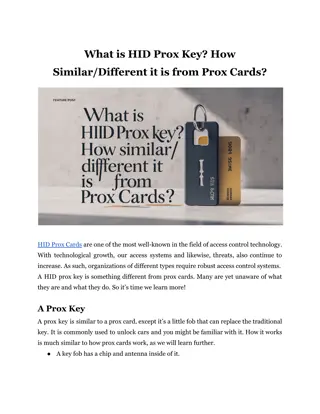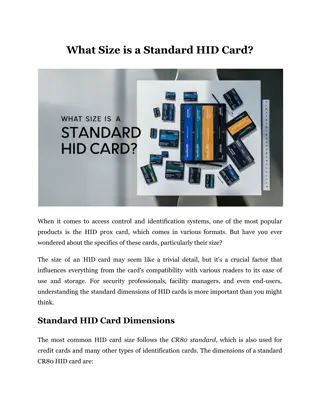
What Types of Systems Support HID Prox Card II
Discover the systems that support HID Prox Card II. Learn how it enhances security and access control in various environments.
Download Presentation

Please find below an Image/Link to download the presentation.
The content on the website is provided AS IS for your information and personal use only. It may not be sold, licensed, or shared on other websites without obtaining consent from the author. Download presentation by click this link. If you encounter any issues during the download, it is possible that the publisher has removed the file from their server.
E N D
Presentation Transcript
What Types of Systems Support HID Prox Card II? Today, organizations are continually seeking innovative solutions from proximity card vendors to manage access to their facilities while ensuring safety and operational efficiency. Among these solutions, the HID Prox Card II stands out as a robust access control technology that leverages the power of proximity card systems. Designed to meet the evolving demands of diverse industries from corporate offices to educational institutions and healthcare facilities it offers an ideal blend of security, convenience, and scalability. As businesses contemplate upgrading their access control systems or implementing new ones, a crucial consideration arises: which systems can effectively support the HID Prox Card II? Understanding the compatibility of these cards with various systems is essential for organizations looking to enhance their security measures.
Overview of HID Prox Card II The HID Prox Card II is a proximity smart card that utilizes radio frequency identification (RFID) technology for secure access control. Operating at a frequency of 125 kHz, these cards communicate with compatible readers, allowing users to gain entry by simply holding the card near the reader. The simplicity and efficiency of HID access control cards have made them a standard in various industries, from corporate offices to educational institutions and government facilities. Key Features of HID Prox Card II Before delving into the systems that support this proximity card, it s essential to highlight some of its key features: Improved Security: It offers advanced security measures, including enhanced encryption, making it more resistant to cloning and unauthorized access. Durability: These cards are designed to withstand the wear and tear of daily use, making them ideal for environments with high traffic. User-Friendly: The proximity smart card technology allows for quick and convenient access, eliminating the need for manual entry methods like keys or PINs. Customizable: Organizations can customize the information stored on the card, enabling features like user profiles, access levels, and time-based access restrictions. Systems Supporting HID Prox Card II Several systems are compatible with HID Prox Card II technology, catering to various organizational needs and requirements. Below are some key types of systems that support these cards: Access Control Systems It is primarily used in access control systems, which manage entry to secured areas. These systems are designed to ensure that only authorized personnel can gain access to
sensitive locations. Access control systems utilizing HID access control cards can be found in numerous settings, including: Corporate Offices: Many companies employ access control systems to restrict entry to specific areas, such as data centers or executive offices. HID Prox Card II cards facilitate secure access while maintaining a seamless experience for employees. Educational Institutions: Schools and universities often use access control systems to secure facilities and manage student and staff access to various buildings, libraries, and laboratories. Healthcare Facilities: Hospitals and clinics utilize these systems to ensure that only authorized personnel can enter restricted areas, such as medication storage rooms and patient records departments. Integrated Security Management Systems Many organizations opt for integrated security management systems that combine access control with other security features such as video surveillance, intrusion detection, and alarm monitoring. These cards can be easily integrated into these systems, offering enhanced security capabilities: Centralized Management: Integrated systems allow security personnel to manage access permissions and monitor activity from a single platform. This streamlined approach improves security oversight and response times. Real-Time Monitoring: Organizations can monitor access in real time, allowing for immediate response to unauthorized access attempts. Time and Attendance Systems They are also compatible with time and attendance systems, which track employee work hours and attendance. By integrating these cards into timekeeping systems, organizations can streamline payroll processing and improve accuracy. Automated Tracking: Employees can simply swipe their proximity smart cards to clock in and out, eliminating manual entry and reducing errors.
Detailed Reporting: Many time and attendance systems offer reporting features that help organizations analyze attendance patterns and make informed staffing decisions. Visitor Management Systems Managing visitor access is critical for many organizations, especially in environments where security is a priority. HID Prox Card II technology can be integrated into visitor management systems to enhance the visitor experience while maintaining security protocols. Pre-Registration: Visitors can be pre-registered and issued HID access control cards for temporary access to specific areas. This process streamlines entry and enhances security by ensuring that only authorized visitors are allowed access. Real-Time Tracking: Organizations can track visitor movements within the facility, providing an added layer of security and accountability. Building Management Systems HID Prox Card II cards can also be incorporated into building management systems, which oversee various facility operations, including lighting, HVAC, and security. By integrating access control into these systems, organizations can enhance overall efficiency. Energy Management: Access control systems can be linked to building management systems to optimize energy usage based on occupancy levels. Enhanced Security Measures: Integrating access control with building management systems allows for more comprehensive security measures, such as locking down specific areas in case of an emergency. Factors to Consider When Choosing a System When evaluating systems that support HID Prox Card II, organizations should consider several factors to ensure they select the best solution for their needs:
1. Scalability: Choose a system that can grow with your organization. This includes the ability to add more users, access points, and features as needed. A scalable system allows you to adapt to changes in your workforce or security requirements without having to replace the entire system, making it a more sustainable long-term investment. 2. Integration Capabilities: Ensure that the access control system can integrate seamlessly with other security and operational systems, such as: Visitor management systems Building management systems A well-integrated system can enhance overall security by providing comprehensive oversight and management from a single platform. This capability also facilitates streamlined processes, improving operational efficiency across departments. 3. User Management Features: Look for systems that offer robust user management capabilities, including the ability to assign different access levels and permissions based on roles. This feature is essential for maintaining security and ensuring that employees only have access to areas pertinent to their roles. Additionally, effective user management: Allows for easier tracking of who is entering secure areas Can help with compliance audits 4. Support and Maintenance: Consider the level of customer support and maintenance offered by the vendor. Reliable support is crucial for addressing any issues that may arise post-installation. A vendor that provides ongoing training and updates can ensure that your system remains effective and secure over time. Evaluate their response times and available resources to ensure your organization receives timely assistance when needed.
5. Cost-Effectiveness: Evaluate the total cost of ownership, including initial setup costs, ongoing maintenance, and any future upgrade expenses. While the upfront cost is important, consider the long-term value of the system in terms of efficiency gains and reduced security risks. An effective cost-benefit analysis can help determine the best option that aligns with your budget and security objectives while allowing for informed decision-making. The Bottom Line The HID Prox Card II serves as a versatile solution that integrates seamlessly with various systems, enabling organizations to protect sensitive areas while ensuring efficient access for authorized personnel. Investing in a robust access control system not only fortifies defenses against unauthorized access but also promotes operational efficiency and user satisfaction. Always know that the right choice can significantly enhance your organization s overall security strategy, paving the way for a safer and more secure environment. As one of the leading proximity card vendors, our team at Bristol ID Technologies understands the importance of secure access control in today s fast-paced environment. Specializing in advanced identification solutions, we offer a wide range of products, including HID Prox Card II technology, designed to meet your organization s unique security needs. Our high-quality proximity cards provide seamless integration with existing systems, ensuring enhanced security and convenience for your team. Contact us today to learn more about our products! Site Article: What Types of Systems Support HID Prox Card II






















